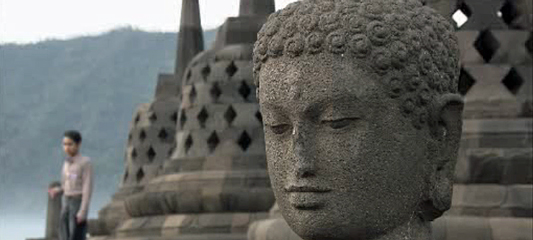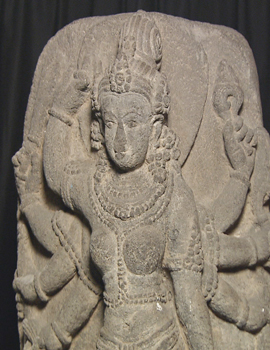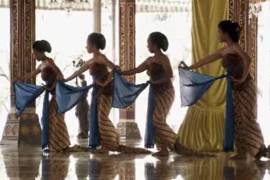
Indonesia’s art of deception
Disappearance of Javan statues casts unwelcome light on international art market.
 |
| Many experts say Indonesia fails to look after its national treasures |
Al Jazeera visited the Indonesian town of Solo and found that the strange disappearance of some valuable statues from a museum, nominally owned by the local royal family, may have had deadly consequences.
The display put on by the dancers and orchestra of the royal court of Solo is certainly a lavish one.
However that is all it is – a display – taking place in an empty courtyard with few spectators. That is because the royal family of this Indonesian city on the central island of Java is in trouble.
Keep reading
list of 4 itemsPalestinian Prisoner’s Day: How many are still in Israeli detention?
‘Mama we’re dying’: Only able to hear her kids in Gaza in their final days
Europe pledges to boost aid to Sudan on unwelcome war anniversary
The ancient sultanate of Surakarta, as Solo is formally known, was once Indonesia’s cultural, political and spiritual centre but independence in 1946 stripped the royal family of most of its influence.
| In depth |
|
|
These days the palace, or Kraton, is a largely symbolic institution, its loss of power accompanied by a loss of income and the death of King Pakubuwono XII in 2004 prompting a bitter succession battle that has torn the royal family apart.
Now a scandal over stolen statues, involving suspected murder, theft, cover-ups, royal intrigue and ruined careers has thrown an unwelcome spotlight on the court and the murky world of the international art market.
At the centre of the story are five valuable statues stolen, along with many other artefacts, from the Radya Pustaka museum in Solo, thought to be the oldest museum in Indonesia.
Empty plinths or clumsy fakes now stand where the statues once did and Djoko Dwiyanto, head of the archaelogy school at the Gadhja Madha university estimates that about 60 per cent of the collection is missing.
Suspicions
This looting had gone on undetected until Andrea Amborowatiningsih, better known as Ambar, a university student working as a guide in the museum in 2005, grew suspicious and suggested a check of the exhibits to make sure they were all there.
 |
| Who initiated the theft of the statues is still unclear |
She was initially told by the museum’s director, Darmodipuro, that some things were in storage and that she should not worry but the continued appearance and unusual behaviour of a man said to be a banker, Heru Suryanto, just increased her suspicions.
“I started getting suspicious when he kept coming to the museum, taking pictures in the parts of the museum where items subsequently went missing,” she tells Al Jazeera.
However after Ambar repeated her suggestion of a full inventory, including the collection’s valuable bronzes, she was sacked and returned to university, the matter apparently closed.
But Ambar later returned simply to visit the museum and noticed some of the statues had been replaced by fakes looking for guidance she approached archaeology experts at her university who put her in touch with Lambang Babar Purnomo, a member of the Central Java Archaeological Preservation Board.
A team led by Lambang and other senior archaeologists checked the museum and produced a survey indicating more than half the exhibits were missing or fake.
Claims and counterclaims
However the investigation – and subsequent police enquiry – quickly found itself in sensitive areas. Namely the museum had been founded by the royal family of Solo and due to the financial woes of the palace suspicions arose that it may have authorised the sale of the statues.
That accusation is rejected by the current King’s sister and royal spokesman, princess Koes Moertiyah, who puts the blame squarely on Darmodipuro, the museum director, and Heru Suryanto, the alleged banker.
The police investigation backed this line up when both were arrested and it emerged Heru was actually an art dealer.
The statues ended up with an eminent Dutch art expert, Hugo Kreijer, who in turn had sold them to one of Indonesia’s richest men, Hashim Djojohadikusumo, whose brother in turn is married to a daughter of the country’s former president, Suharto.
Kreijer used to work for the prestigious Christie’s auction house and insists the sale was legal and that he bought the statues from the King of Solo, he says, with valid documents, including letters from the King himself.
That assertion is challenged by the royal family who say the documents, copies of which have been obtained by Al Jazeera,were forgeries.
However, humiliatingly, the current King, the reclusive Pakubuwono XIII, formerly prince Hangabehi, has been questioned by police about the thefts.
 |
| The royal family in Solo has little real influence or power |
The palace plays down the investigation saying it was a routine inquiry but the King’s brother and rival, Prince Tedjowulan has seized on it to promote his own claim to their throne.
“As a secretary to the Royal Family I can state that all the documents were false including the letterhead, stamp and signature,” Koes Moertiyah told Al Jazeera.
Mysterious death
Kriejer retorted if this was true then he and his client, who paid $100,000 for the statues, were conned and points out that he would be foolish to steal to steal from a museum to then exhibit the works in a public institute.
He says the statues would have been displayed in Hashim Djojohadikusumo’s planned museum and library in Jakarta, a project aiming to preserve the nation’s heritage under ideal conditions – something rare in Indonesia’s cash-strapped museums.
However the claims and counterclaims over the missing statues were overshadowed when Lambang Babar Purnomo was found dead in February just outside Yogyakarta, two hours drive from Solo, near his motorcycle.
It was initially thought the archaeological expert was killed in a hit and run incident but local newspapers quoted police as saying his injuries were unusual for a traffic accident and family members and Ambar say he had been receiving death threats over his investigations into the missing statues.
It remains unclear exactly how he died and who was responsible but that there is even the suspicion of a murder over five weathered statues says much about the new global market in Indonesian art.
Panembahan Hardjonogoro is a collector who scoured the countryside when he was young and says the new international market – and a sense of national pride – has sent the price of Indonesian antiquities spiraling upwards.
“During my youth young people would be busy looking for birds but I was more interested in stone statues, even partially damaged ones and I would ask people in the villages if I could buy them and take them home,” he says.
“Usually they’d be more than happy to sell them. At that time they cost less than a plate of fried rice.”
Criminal element
In 1985 Panembahan was offered two million dollars for his own collection; a price that now would be multiplied many times but says he will not sell and instead leave his work to the country when he dies.
But the huge sums of money involved in the sale of such antiquities has attracted a criminal element into the trade.
 |
| Even the King was questioned during the probe into the removal of the statues |
“I’ve never met Heru but there are others like him, assuming the police are right and he’s guilty, he’s not alone – there are many others like him working secretly,” Djoko Dwiyanto says.
“It’s their career. They may be working for owners of antique items, like for example the Kraton, or even collectors.”
The museum in Solo is particularly vulnerable to such unscrupulous dealers.
Despite claiming it founded and owns the museum the royal family provides little or no funding for either staff, upkeep of the building or the collections as it is simply too poor to do so.
With neither the palace nor the government nor the town council taking responsibility for the museum in any real sense, some experts say it’s not surprising that staff have had to resort to desperate measures.
Such measures have led the museum director Darmodipuro and the dealer Heru into jail but who instigated the theft remains a mystery.
Suspicions remain over the Dutch art dealer, the royal family, even the tycoon in whose possession they were eventually found.
But Djoko says the whole saga simply underlines the basic failure of Indonesia to guard its national treasures.
“Generally the management of museums in Indonesia is very poor,” he says. “The government have several times tried to introduce the concept of a modern museum but it has never worked.”
Even monuments as famous as the central Javanese temple of Borobudur have had statues stolen and offered for sale in recent years.
That is an indication of the size of the struggle facing those tasked with preserving the country’s past.
The Art of Deception airs from Saturday, March 29, 2008 at the following times GMT:
Saturday 29th March, 14:30, 22:30, Sunday 30th March, 02:30, 12:30, Monday 31st March 00:30, Tuesday 1st April, 13:30, Wednesday 2nd April, 11:30, 19:30, Thursday 3rd April, 05:30, Friday 4th April, 03:00, 10:30, 16:30, Saturday 5th April, 06:30
